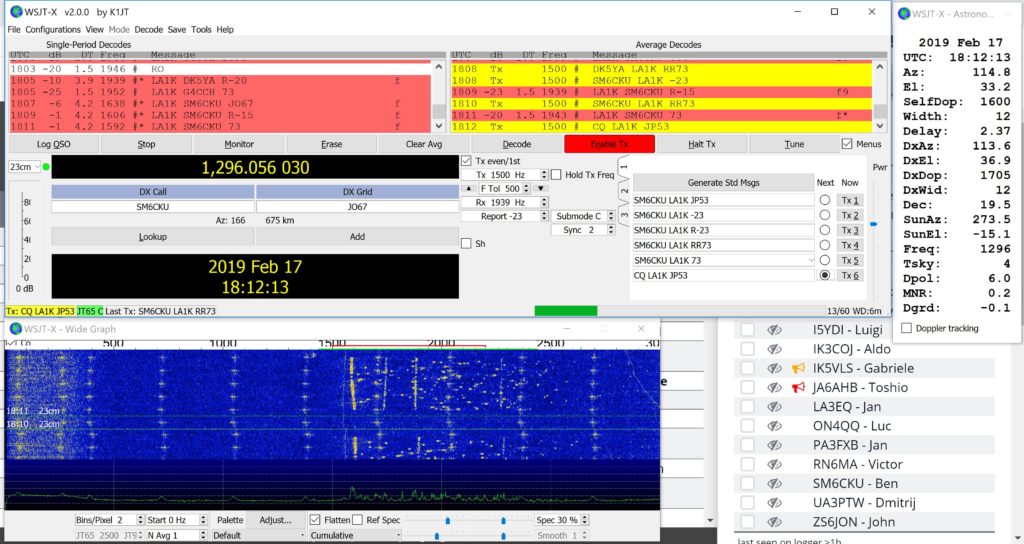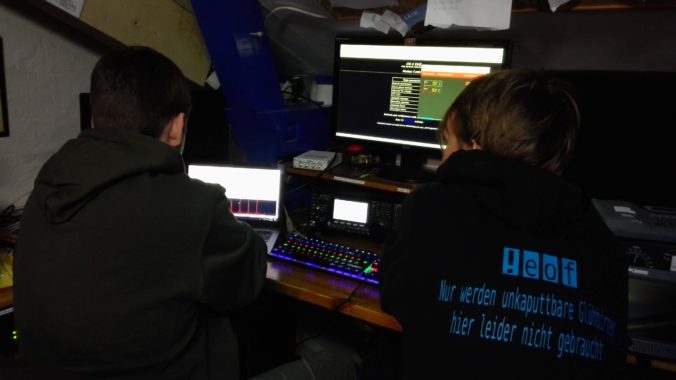Two weeks ago, we wrote about being ready with our 23 cm EME setup, and how we worked the first contact. After the first contact we also had time to work some more, before we were collectively bitten by the QO-100 bug.
Here is a short report on the contacts we got to work, before realizing that the moon is only well-behaved and available for a given period. The contacts we worked were all done using WSJT-X with the JT65C mode.
-- Monday 11 February--
17:08 UTC SP5GDM KO02 SNT:RO RCV: RO DXCC
-- Wednesday 13 February --
17:40 UTC PA3FXB JO33 SNT: OOO RCV: RO
18:05 UTC RN6MA LN06 SNT: OOO RCV: RO DXCC
-- Sunday 17 February --
17:35 UTC JA6AHB PM53 SNT: -06 RCV: -16 DXCC
18:01 UTC G4CCH IO93 SNT:-02 RCV:-13
18:07 UTC DK5YA JN49 SNT:-10 RCV:-20
18:11 UTC SM6CKU JO67 SNT:-23 RCV: -15
18:22 UTC I5YDI JN54 SNT:-14 RCV:-19
18:26 UTC UA3PTW KO93 SNT: -02 RCV: -14
18:29 UTC F1RJ JN18 SNT: -15 RCV: -15 DXCC
18:34 UTC DL8FBD JO40 SNT:-13 RCV:-25
18:38 UTC IK3COJ JN65 SNT:-09 RCV:-16
18:42 UTC OK1IL JN69 SNT:-10 RCV: -19
18:46 UTC DJ9YW JO42 SNT: -08 RCV: OOO
18:54 UTC DF2VJ JN39 SNT: -17 RCV: RO
19:00 UTC RN6MA LN06 SNT:-16 RCV:-20
Some of the contacts above are marked with DXCC, those are new DX entities worked by LA1K on 23 cm EME.
It turns out that LA1K has actually been operative on 23 cm EME before, however not from our primary QTH at Samfundet (JP53EK). Therefore, only some of the new contacts are new DX entities for us – but all of them are new initial contacts between LA1K at JP53EK, and the respective stations at their grid square.
The aforementioned operation was an expedition to the solar observatory at Harestua (JP50JF), where LA1K borrowed the observatory’s 10 m dish to work 23 cm contacts on SSB and CW back in 1989. This is probably an interesting topic for a future blogpost, if we are able to get more information from our archives.

We were absolutely floored to see that it was possible to get an hour long pileup running. To those we have worked so far – thank you for the very warm welcome to the moon! We are really excited for the next lunar peak, and look forward to be able to work many more contacts.


0 Comments
1 Pingback